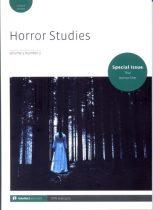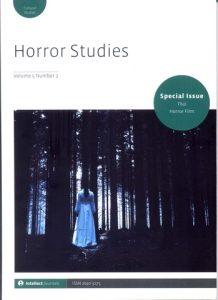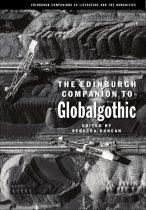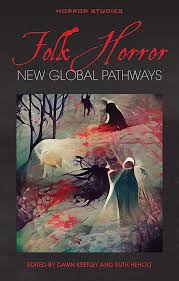2021
 This paper offers a reading of Anjaan: SCU as an example of Gothic television placed in the context of Globalgothic. The article situates Anjaan: SCU within a larger body of supernatural detective series, the genre that has contributed significantly to Asian television’s global presence, investigates the gothic themes employed in the creation of the show, both in terms of its narrative strategies and visual aesthetics, and examines the social construction of ghosts in the series. The article argues that the narrative structure of the show operating across legal and mythical dimensions serves a didactic purpose and that these modern reconfigurations of Indian ghost lore aim to dispense social critique and address controversial local issues, such as caste-based inequality, female infanticide, or ‘honour’ killings.
This paper offers a reading of Anjaan: SCU as an example of Gothic television placed in the context of Globalgothic. The article situates Anjaan: SCU within a larger body of supernatural detective series, the genre that has contributed significantly to Asian television’s global presence, investigates the gothic themes employed in the creation of the show, both in terms of its narrative strategies and visual aesthetics, and examines the social construction of ghosts in the series. The article argues that the narrative structure of the show operating across legal and mythical dimensions serves a didactic purpose and that these modern reconfigurations of Indian ghost lore aim to dispense social critique and address controversial local issues, such as caste-based inequality, female infanticide, or ‘honour’ killings.



 While folk horror has never been identified as exclusive to western cinema, most studies of the topic have so far been strongly aligned with western world-views, philosophies and methodologies. This makes it difficult to apply their findings to films made in non-Christian non-western countries, such as Thailand. This article discusses Banjong Pisanthanakun’s film Rang Song (The Medium) (2021) as a case in point to demonstrate how folk horror operates as a mode in Thai cinema. Building on the existing studies and modifying the current definitions of folk horror to apply them to the Thai cultural context, the article argues that Thai folk horror narratives are steeped in representations of the urban–rural divide that pit metropolitan Bangkok against low-income provinces (in particular, the northeastern region of Isan) and reflect on cultural tensions related to ethnicity and class.
While folk horror has never been identified as exclusive to western cinema, most studies of the topic have so far been strongly aligned with western world-views, philosophies and methodologies. This makes it difficult to apply their findings to films made in non-Christian non-western countries, such as Thailand. This article discusses Banjong Pisanthanakun’s film Rang Song (The Medium) (2021) as a case in point to demonstrate how folk horror operates as a mode in Thai cinema. Building on the existing studies and modifying the current definitions of folk horror to apply them to the Thai cultural context, the article argues that Thai folk horror narratives are steeped in representations of the urban–rural divide that pit metropolitan Bangkok against low-income provinces (in particular, the northeastern region of Isan) and reflect on cultural tensions related to ethnicity and class.
 This article discusses three major media forms that drive the globalisation of Asian Gothic: literature originally written in English, film, and original television series created specifically for global SVOD platforms like Netflix, Amazon Prime or HBO Go. The article focuses in more detail on three texts: a novel Ponti (2018) written by a Singaporean author Sharlene Teo, discussed in a larger context of texts featuring a Malay monster known as the pontianak; a Taiwanese film The Tag-Along (Cheng 2015) examined in relation to other East Asian films that feature forest-dwelling child-like spirits/demons that imitate human voice and lure their victims into the wilderness; and an Indonesian mini-series Halfworlds (2015) produced by HBO Asia and directed by Joko Anwar, which will be situated in the context of the director’s overall engagement with folk horror. The article argues that such productions promote an understanding of globalgothic in terms of texts that reconfigure elements of Gothic in order to negotiate transnational relationships from the socio-historical or cultural vantage point of a certain region, in this case the regions of East and Southeast Asia, and that these texts are to a large extent the results of specific production and distribution practices and strategies characteristic of global media.
This article discusses three major media forms that drive the globalisation of Asian Gothic: literature originally written in English, film, and original television series created specifically for global SVOD platforms like Netflix, Amazon Prime or HBO Go. The article focuses in more detail on three texts: a novel Ponti (2018) written by a Singaporean author Sharlene Teo, discussed in a larger context of texts featuring a Malay monster known as the pontianak; a Taiwanese film The Tag-Along (Cheng 2015) examined in relation to other East Asian films that feature forest-dwelling child-like spirits/demons that imitate human voice and lure their victims into the wilderness; and an Indonesian mini-series Halfworlds (2015) produced by HBO Asia and directed by Joko Anwar, which will be situated in the context of the director’s overall engagement with folk horror. The article argues that such productions promote an understanding of globalgothic in terms of texts that reconfigure elements of Gothic in order to negotiate transnational relationships from the socio-historical or cultural vantage point of a certain region, in this case the regions of East and Southeast Asia, and that these texts are to a large extent the results of specific production and distribution practices and strategies characteristic of global media.
 This article discusses the construction of phi pop as the monstrous figure of Thai folklore and proposes to read phi pop films as a classic example of Thai folk horror – a local sub-genre of horror whose main convention seems to be the representation of the insurmountable rural/urban divide. The films take different approaches to the topic, and the cinematic phi pop emerges as a figure of both comedy and horror, although in newer productions where the creature is no longer isolated in a remote village but rather follows rural migrants into the city, its portrayals are significantly more unnerving. The chapter provides a brief overview of Thai beliefs concerning the origin and characteristics of the creature and examines four films representative of most common approaches to Thai folk horror: Ban Phi Pop (Srisawat 1989), P (Spurrier 2005), Mekong Hotel (Weerasethakul 2012) and Pob (Ratanaruang 2018).
This article discusses the construction of phi pop as the monstrous figure of Thai folklore and proposes to read phi pop films as a classic example of Thai folk horror – a local sub-genre of horror whose main convention seems to be the representation of the insurmountable rural/urban divide. The films take different approaches to the topic, and the cinematic phi pop emerges as a figure of both comedy and horror, although in newer productions where the creature is no longer isolated in a remote village but rather follows rural migrants into the city, its portrayals are significantly more unnerving. The chapter provides a brief overview of Thai beliefs concerning the origin and characteristics of the creature and examines four films representative of most common approaches to Thai folk horror: Ban Phi Pop (Srisawat 1989), P (Spurrier 2005), Mekong Hotel (Weerasethakul 2012) and Pob (Ratanaruang 2018).
 The chapter offers a selective survey of twenty-first-century Asian Gothic. The main focus of the discussion is the most prominent contemporary trend involving reconfigurations of Asian folklore and the ghost story. More specifically, this chapter investigates literary and film narratives dealing with individual and collective trauma that revolve around the figure of the vengeful ghost, texts which reclaim animism as inherent part of Asian modernity, and Asian Gothic’s interrogation of gender dynamics and empowered women. The first section of the essay discusses the emergence of the female vengeful ghost as the dominant figure of fear in Asian horror films. The second section examines the portrayal of ghosts in literature of the region and the way their haunting engages with historical trauma and socio-cultural anxieties of the time. The final part investigates narratives that highlight the connection of women to shamanism and magic and proposes to read female spirituality in terms of empowerment.
The chapter offers a selective survey of twenty-first-century Asian Gothic. The main focus of the discussion is the most prominent contemporary trend involving reconfigurations of Asian folklore and the ghost story. More specifically, this chapter investigates literary and film narratives dealing with individual and collective trauma that revolve around the figure of the vengeful ghost, texts which reclaim animism as inherent part of Asian modernity, and Asian Gothic’s interrogation of gender dynamics and empowered women. The first section of the essay discusses the emergence of the female vengeful ghost as the dominant figure of fear in Asian horror films. The second section examines the portrayal of ghosts in literature of the region and the way their haunting engages with historical trauma and socio-cultural anxieties of the time. The final part investigates narratives that highlight the connection of women to shamanism and magic and proposes to read female spirituality in terms of empowerment.